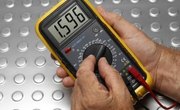When you want to make sure your weighing scale tells you how much you actually weigh, you can test that it reads "0" when there's nothing on it. You can use this technique, known as calibration, for many devices that perform measurements. If you're curious about the nature of electronic signals, oscilloscopes can come in handy, but you'll need to calibrate these as well.
Setting up the Oscilloscope
You can use oscilloscopes to measure electronic signals. These devices output a waveform, a curve representing the electric signal for an input voltage or power source. Before you can use it to make measurements, you should calibrate with a known amount of controlled values of the oscilloscope. This ensures your measurements are accurate to standards accepted by scientists and engineers.
Before you begin the oscilloscope calibration procedure, ground the oscilloscope to protect yourself from being shocked and protect your circuits from becoming damaged. To do this, plug the three-pronged power cord into an outlet that's grounded into the Earth. You need an electrically neutral reference point to send any excess electrical power to the ground, but using cases that insulate oscilloscopes to prevent charge from escaping can work, too.
Set the oscilloscope to view the first channel, and select the mid-range position for the vertical scale for volts (or division) and for the scale for the position controls. Turn off variable volts (or division) as well as the magnification settings, and set the first channel input to direct current (DC). Set the trigger mode to automatic so that it can stabilize the trace of the waveform's shape, and set the trigger source to the first channel.
Make sure the trigger hold-off is at a minimum or turned off. This makes sure the device uses as little time as possible between waveforms. Use mid-range positions for the horizontal time (or division) controls. Change the first channel volts so the signal has as many of the vertical dimensions it can occupy as possible.
Oscilloscope Calibration Procedure
Connect the probe of the oscilloscope so you can measure each value that needs to be calibrated. You can do this by connecting the ground tip to a ground material with a known current and voltage in an electrical circuit and touch the probe tip to a test point so you can, then, adjust the oscilloscope to match the properties of the known.
Change the oscilloscope's controls for x-position, y-position, time, volts, intensity and focus until the waveform matches the known material's properties. You can also calibrate channel switching, vertical channels, bandwidth, pulse response, rise time, cursors and whatever else an oscilloscope measures as accurately as you desire.
You can also connect the probe to the oscilloscope's calibration terminal with a voltage label. This calibration terminal should display a square wave that you can adjust to make sure it's calibrated. It's best to use alligator clip test probes for calibration, so, if you have a pointed tip instead, you can try to push the tip through the small hole of the calibration terminal to keep it secure in place.
The Importance of Calibration
Calibrating an instrument helps you make sure the standards it uses for certain amounts and quantities that it measures are equal to the standards that scientists and engineers use. Many companies perform calibration tests upon request, and some even provide specific instructions on calibrating their own instruments.
If you wanted to calibrate Tektronix oscilloscopes, for example, you can request oscilloscope calibration services or you can view their instructions for general oscilloscope calibration.
You should calibrate your instruments and continuously check to make sure they're calibrated so you can address problems in a proactive, cautionary manner to anticipate changes such as how a change in ambient temperature may change oscilloscope measurements. This can make your research results more reliable and give you
References
About the Author
S. Hussain Ather is a Master's student in Science Communications the University of California, Santa Cruz. After studying physics and philosophy as an undergraduate at Indiana University-Bloomington, he worked as a scientist at the National Institutes of Health for two years. He primarily performs research in and write about neuroscience and philosophy, however, his interests span ethics, policy, and other areas relevant to science.
